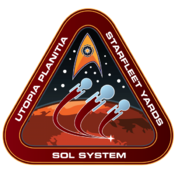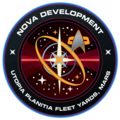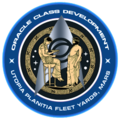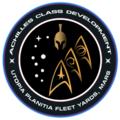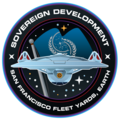Starfleet Ship Classes: Difference between revisions
No edit summary |
No edit summary |
||
| Line 1: | Line 1: | ||
{{Utopia Planitia}}__NOTOC__ | {{Utopia Planitia}}__NOTOC__ | ||
<font size=4>'''Advanced Starship Design Bureau Technical Database'''</font> | |||
<hr style="background:maroon; height:2px"> | |||
The Advanced Starship Design Bureau (ASDB) classifies vessels according to their primary mission profiles, which in turn determine the sizes, shapes, and systems of vessels in a particular category. A ship whose primary purpose is to explore distant star systems will have a different shape and different systems than one intended to escort merchantmen in times of conflict. | |||
However, one of Starfleet's primary moral and tactical principles is that of adaptability. Thus, unlike the often more mission-dedicated vessels of the Klingon Empire or Romulan Star Empire, any Starfleet ship can perform a wide variety of missions (even ones for which it is not primarily designed). For example, a Starfleet escort will have more advanced scientific and research systems than a comparative Klingon vessel | However, one of Starfleet's primary moral and tactical principles is that of adaptability. Thus, unlike the often more mission-dedicated vessels of the Klingon Empire or Romulan Star Empire, any Starfleet ship can perform a wide variety of missions (even ones for which it is not primarily designed). For example, a Starfleet escort will have more advanced scientific and research systems than a comparative Klingon vessel but will not be as heavily armed. Nevertheless, Starfleet ships are best used for the primary missions for which they were created. | ||
===Active Starship Classes=== | |||
Starship classes in active service are listed below. You can also access more information about each specific type of starship by selecting from the menu on the right or read about the various [[Small Craft|small craft]] employed by Starfleet such as [[shuttlecraft]] and [[runabouts]]. | |||
{{UP Class Link|Oberth|Light Science Vessel • 150.81 meters}} | |||
{{UP Class Link|Nova|Planetary Surveyor • 165 meter}} | |||
{{UP Class Link|Defiant|Escort • 170.68 meters}} | |||
{{UP Class Link|Saber|Light Cruiser • 190 meters}} | |||
{{UP Class Link|Miranda|Medium Cruiser • 277.76 meters}} | |||
{{UP Class Link|Intrepid|Light Explorer • 345 meters}} | |||
{{UP Class Link|Norway|Medium Cruiser • 364.77 meters}} | |||
{{UP Class Link|Steamrunner|Medium Cruiser • 366 meters}} | |||
{{UP Class Link|Horizon|Research Science Vessel • 400.25 meters}} | |||
{{UP Class Link|Dakota|Medium Cruiser • 405 meters}} | |||
{{UP Class Link|Prometheus|Heavy Cruiser • 415 meters}} | |||
{{UP Class Link|Nebula|Explorer • 442.23 meters}} | |||
{{UP Class Link|Luna|Reconnaissance Science Vessel • 449.2 meters}} | |||
{{UP Class Link|Akira|Heavy Cruiser • 464.43 meters}} | |||
{{UP Class Link|Oracle|Deep Space Science Vessel • 580 meters}} | |||
{{UP Class Link|Excelsior|Explorer • 511.25 meters}} | |||
{{UP Class Link|Achilles|Heavy Cruiser • 612 meters}} | |||
{{UP Class Link|Galaxy|Explorer • 642.51 meters}} | |||
{{UP Class Link|Vesta|Explorer • 672 meters}} | |||
{{UP Class Link|Sovereign|Explorer • 685.3 meters}} | |||
{{UP Class Link|Odyssey|Explorer • 1028 meters}} | |||
{{Utopia Planitia footer}} | {{Utopia Planitia footer}} | ||
[[Category:Starfleet ship classes|*]] | [[Category:Starfleet ship classes|*]] | ||
Revision as of 23:32, 25 November 2014
| Utopia Planitia Fleet Yards |
|---|
|
Advanced Starship Design Bureau Technical Database The Advanced Starship Design Bureau (ASDB) classifies vessels according to their primary mission profiles, which in turn determine the sizes, shapes, and systems of vessels in a particular category. A ship whose primary purpose is to explore distant star systems will have a different shape and different systems than one intended to escort merchantmen in times of conflict. However, one of Starfleet's primary moral and tactical principles is that of adaptability. Thus, unlike the often more mission-dedicated vessels of the Klingon Empire or Romulan Star Empire, any Starfleet ship can perform a wide variety of missions (even ones for which it is not primarily designed). For example, a Starfleet escort will have more advanced scientific and research systems than a comparative Klingon vessel but will not be as heavily armed. Nevertheless, Starfleet ships are best used for the primary missions for which they were created. Active Starship ClassesStarship classes in active service are listed below. You can also access more information about each specific type of starship by selecting from the menu on the right or read about the various small craft employed by Starfleet such as shuttlecraft and runabouts.
|
- Black-and-white ship illustrations by Tim Davies unless otherwise noted. Used with permission. All other images are copyright to their respective owners.
- Black-and-white ship illustrations by Tim Davies unless otherwise noted. Used with permission. All other images are copyright to their respective owners.
| REV SD 239111.25 |
|---|

